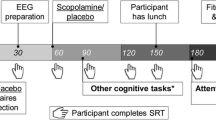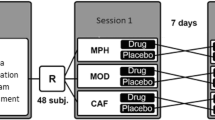Abstract
Single oral doses of promethazine (12.5 mg, 25 mg), scopolamine (0.6 mg), and cinnarizine (30 mg), were compared in a double-blind, placebo controlled trial. Twelve normal volunteers undertook a battery of psychological performance tests and a feeling state questionnaire, before drug administration, and at 2-h intervals after. Promethazine and cinnarizine significantly impaired psychomotor performance, information processing and feelings of alertness. With promethazine these reductions were maximal 3–4 h post-drug, with performance returning near to baseline 8–9 h post-drug. With cinnarizine these impairments were maximal 5–6 h post-drug, and performance remained depressed 8–9 h post-drug. Scopolamine significantly reduced feelings of alertness, and memory task performance; the overall performance effects were most evident 1–4 h post-drug.
Similar content being viewed by others
References
Baddeley A (1968) A three minute reasoning test based on grammatical transformation. Psychonom Sci 10:341–342
Bain W (1949) Comparison of anthisan and phenergan as histamine antagonists. Lancet II:47–52
Bowman W, Rand M (1980) Textbook of pharmacology. Blackwell, Oxford
Brand J, Perry W (1966) Drugs used in motion Sickness. Pharmacol Rev 18:895–924
Clarke C, Nicholson A (1978) Performance studies with antihistamines. Br J Clin Pharmacol 6:31–35
Cobb S, Coen L, Gitomer S, Hest R (1976) Effect of cinnarizine on nystagmus induced by rotation-deceleration. Eye Ear Nose and Throat Monthly, January
Colquohoun W (1971) Effects of hyoscine and meclozine on vigilance and short term memory. Br J Ind Med 19:287–296
Deutsch J (1971) The cholinergic synapse and the site of memory. Science 174:788–794
Douglas W (1975) Histamine and antihistamines. In: Goodman L, Gilman A (eds) Pharmacological basis of therapeutics. Macmillan, New York
Gillard A, Verduin C (1983) The combined effects of an antihistamine and pseudoephedrine on human performance. J Drug Res 8:1929–1935
Ghoneim M, Mewaldt S (1975) Effects of diazepam and scopolamine on storage, retrieval, and organisational processes in memory. Psychopharmacologia 44:257–262
Glaser E (1953) Experiments on side effects of drugs. Br J Pharmacol 8:187–192
Graybiel A (1980) Space motion sickness: skylab revisited. Aviat Space Environ Med 51:814–822
Hargreaves J (1980) A double-blind placebo controlled study of cinnarizine in the prophylaxis of seasickness. Practitioner 224:547–550
Hedges A, Hills M, Mackay WP, Newman-Taylor AJ, Turner P (1971) Some central and peripheral effects of meclastine, a new antihistaminic drug, in man. J Clin Pharmacol 11:112–119
Hordinsky J, Beier J, Schwartz E, Martin J, Aust G (1982) Relative efficacy of the proposed space shuttle antimotion sickness medications. Acta Astronautica 9:375–383
Innes I, Nickerson C (1975) Atropine, scopolamine and related anti-muscarinic drugs. In: Goodman L, Gilman A (eds) The pharmacological basis of therapeutics. Macmillan, New York
Jensen A, Rohwer W (1966) The Stroop colour-word test: a review. Acta Psychol 25:36–93
Kirk R (1968) Experimental design procedures for the behavioural sciences. Brooks-Cole, California
Kohl R, Homick J (1983) Motion sickness: a modulatory role for the central cholinergic nervous system. Neurosci Biobehav Rev 7:73–85
Large A, Wayte G, Turner P (1971) Promethazine on hand-eye coordination and visual function. J Pharm Pharmacol 29:134–135
Lukomskya N, Nikolskay M (1971) Search for drugs against motion sickness. Sechenov Institute, Leningrad. (Translation: Defence and Civil Institute of Environmental Medicine, Ontario)
McMurray G (1973) An evaluation of Metclopramide as an antiemetic in seasickness. Postgrad Med J [Suppl]:38–41
Molson G, Mackay J, Smart J, Turner P (1966) Effect of promethazine hydrochloride on hand eye coordination. Nature 209:516
Nicholson A (1985) Central effects of H1 and H2 antihistamines. Aviat Space Environ Med 56:293–298
Parrott A (1986) The effects of transdermal scopolamine and four doses of oral scopolamine (0.15, 0.3, 0.6, 1.2 mg) upon psychological performance. Psychopharmacology 89:347–354
Parrott A, Jones R (1985) Effects of transdermal scopolamine upon psychological test performance at sea. Eur J Clin Pharmacol 28:419–429
Payne R, Moore E, Bethrum J (1952) The effects of certain motion sickness preventatives upon psychological proficiency. Project report no:21-32-019; USAF School of Aviat Med Texas
Payne R, Moore E, Bethrum J (1953) The effects of certain motion sickness preventatives upon navigator proficiency. Project Report No 21-1601-0004, USAF School of Aviat Med Texas
Poulton E, Edwards R (1974) Interactions, range effects and comparisons between tasks in experiments measuring performance with pairs of stresses: mild heat and 1 mg of 1-hyoscine hydrobromide. Aerosp Med 45:735–741
Reason J, Brand J (1982) Motion sickness. Academic, London
Schroeder D, Collins W, Elam G (1982) Effects of some motion sickness depressants on tracking performance. FAA Civil Aeronautical Institute Report, Oklahoma, FAA-AM-82-19
Smith J, Misiac H (1975) Critical Flicker fusion (CFF) and psychoactive drugs in normal subjects: a review. Psychopharmacology 47:175–182
Stott J, Hubble M, Spencer M (1984) A double blind comparative trial of powdered ginger root, hyoscine, and cinnarizine in the prophylaxis of motion sickness. In: Motion sickness: mechanisms, prediction, prevention and treatment. AGARD conference proceedings: number 372. NATO publication, Neuilly, France
Towse G (1980) Cinnarizine: a labyrinthine sedative. J Laryngol Otol 94:1009–1015
Trumbull R, Chinn H, Maag C, Milch L, Handford S, Siebert R, Sperling P, Smith P (1960) Effect of certain drugs on the incidence of seasickness. Clin Pharmacol Ther 1:280–283
Turner P (1968) Critical flicker frequency and centrally acting drugs. Br J Opthalmol 52:245–250
Warburton D (1975) Brain behaviour and drugs. Wiley, London
Warburton D, Wesnes K (1984) Drugs as research tools in psychology: cholinergic drugs and information processing. Neuropsychobiology. 11:121–132
Wesnes K, Revell A (1984) The separate and combined effects of scopolamine and nicotine on human information processing. Psychopharmacology 84:5–11
Wesnes K, Warburton D (1983) Effects of scopolamine on stimulus sensitivity and response bias in a visual vigilance task. Neuropsychobiology 9:154–157
Wesnes K, Warburton D (1984) Effects of scopolamine and nicotine on human rapid information processing. Psychopharmacology 82:147–150
Wilkinson R, Houghton D (1975) Portable four choice reaction time test with magnetic tape memory. Behav Res Meth Instr 7:441–446
Wood C (1979) Antimotion sickness and antiemetic drugs. Drugs 17:471–479
Wood C, Graybiel A (1968) Evaluation of 16 antimotion sickness drugs under controlled laboratory conditions. Aerosp Med 39:1341–1350
Wood C, Graybiel A (1970) A theory of motion sickness based on pharmacological reactions. Clin Pharmacol Ther 11:621–629
Wood C, Manno J, Manno B, Redetzki H, Wood M, Mins M (1985) Evaluation of antimotion sickness drug side effects on performance. Aviat Space Environ Med 56:310–316
Author information
Authors and Affiliations
Rights and permissions
About this article
Cite this article
Parrott, A.C., Wesnes, K. Promethazine, scopolamine and cinnarizine: comparative time course of psychological performance effects. Psychopharmacology 92, 513–519 (1987). https://doi.org/10.1007/BF00176487
Received:
Revised:
Issue Date:
DOI: https://doi.org/10.1007/BF00176487




